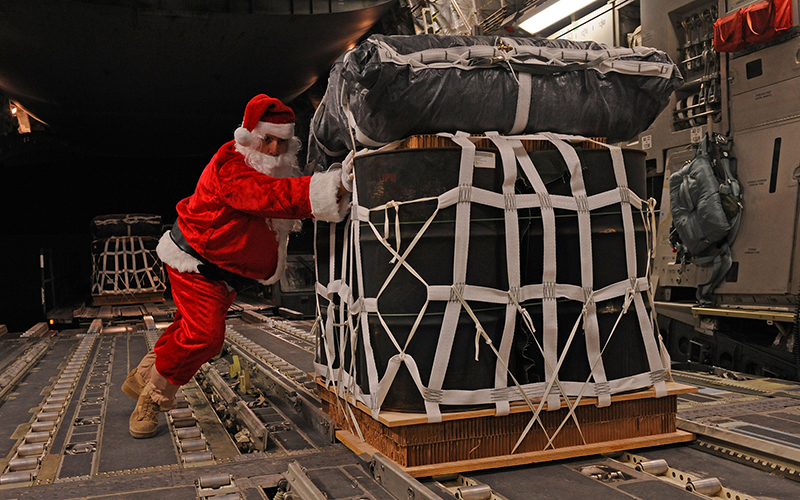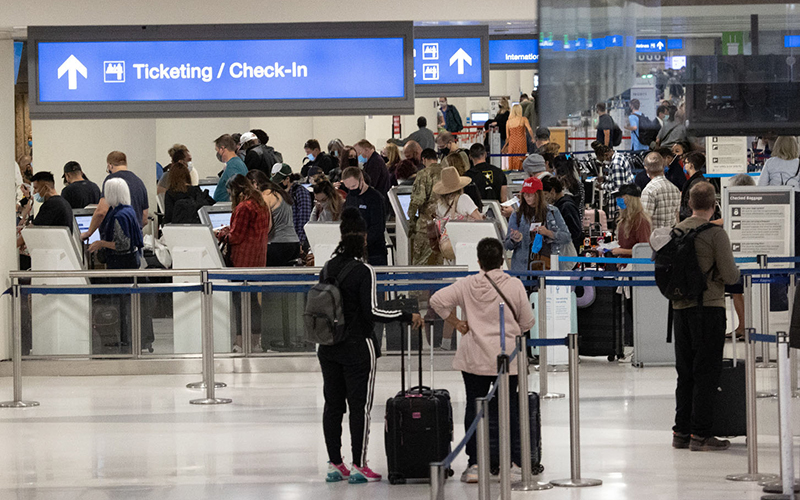
Marines with the Blue Angels help Santa make a Toys for Tots delivery in this photo from 2012. Santa could be especially busy this year, as retailers predict holiday sales could grow up to 10% over last year, to as much as $859 billion, as heavy online sales combine with a return to in-person shopping. (Photo by Sgt. Aaron Hostutler/U.S. Marine Corps)
WASHINGTON – In the second holiday season of the pandemic era, goods may cost more, but Americans have more money to spend – and they appear to be eager to spend it.
That’s true in Arizona, where retailers say the holiday shopping season is already in full swing and residents are expected to spend anywhere from $590 to $1,558 on their shopping, according to one recent estimate.
And while Black Friday remains popular, experts say many shoppers started opening their wallets months ago. Katherine Cullen of the National Retail Federation said the Thanksgiving weekend rush is “not the kickoff to the season that it used to be.”
“We consider it more of the halfway point,” said Cullen, the NRF’s senior director of industry and consumer insights. “But it’s something that consumers really enjoy as part of their Thanksgiving tradition.”
Hitendra Chaturvedi said it’s an acceleration of a trend that was seen in previous holidays.

Americans are expected to spend an average of $886 on gifts this holiday season. Spending in Arizona cities, in one survey, could range from $590 in Tucson to $1,558 in Gilbert. (Photo courtesy U.S. Department of Energy)
“That same trend that was happening even before COVID – where people are going online and a lot more Black Fridays are happening in September – just accelerated,” said Chaturvedi, a professor in supply chain management at Arizona State University’s W. P. Carey School of Business.
“Eighty-five percent of the U.S. population would have done their holiday shopping by Cyber Monday,” he said, something that’s “never been done before.”
The NRF’s Annual November Holiday Customer Survey said that more than 158 million people will holiday-shop over Thanksgiving weekend, 108 million on Black Friday alone. But it also said that 61 percent of those “had already begun their holiday shopping,” slightly up from last year’s 59%, but 10 percentage points higher than the rate in 2011.
This holiday season comes at a time when many Americans have more cash on hand, after a year in which the government doled out pandemic stimulus payments and the job market steadily improved.
Chaturvedi is also a featured expert for WalletHub, a Washington, D.C.-based personal finance site, which came out with a report last week saying Arizonans could spend as much as $1,558 per person on gifts this holiday season.
WalletHub’s 570-city list looks at income, age, debt, expenses and savings to generate an estimate of per-person holiday spending by city. Of the 15 Arizona cities on the list, Gilbert was at the top, with projected spending of $1,558 this holiday. Tucson residents are expected to spend the least in the state, at an estimated $590.
Gilbert was in 73rd place and Tucson was 532nd on WalletHub’s national list, where the median holiday budget for cities was $889.
A Gallup report released this week came to much the same conclusion, predicting that Americans planned to spend an average of $886 on holiday gifts this year, up from $852 last year.
Despite fears of supply chain problems disrupting holiday shopping, the interim president and CEO of the Tucson Chamber of Commerce said that retailers there seem to be doing OK so far.
Michael Guymon, the CEO, said any supply chain problems that Tucson is facing have less to do with household consumers, and more to do with larger-scale operations like “a construction company trying to build houses to meet the demands of the market.”
“It’s not as much in the retail space that we’re seeing problems” of supply chain complications, he said, but added that the chamber has had to help retailers “figure out how to pivot to have product online” through the holiday season.
“Online sales have trended up over the last five years,” he said, but more so “during the recent months of the pandemic.”
That was echoed in the Gallup report, where Lydia Saad said that while some of the recent increase in e-commerce “could be a natural extension of the long-term increase in online shopping, it likely also reflects more people adopting the practice during the pandemic.”
E-commerce sales totaled $214 billion in the third quarter of 2021, about 13% of total retail sales in the quarter, according to the Census Bureau.

Santa has not abandoned his sleigh for a C-17 Globemaster – but gift-giving is likely to be up this year. Here, Air Force Tech. Sgt. Mike Morris loads fuel bound for Afghanistan on Dec. 23, 2011. (Photo by Staff Sgt. Nathanael Callon/U.S. Air Force)
Most of the online business has gone toward chain stores like Walmart, Target and Home Depot, Chaturvedi said. He said the pandemic’s effect on the economy “was industry agnostic, but it was not size agnostic.”
“Businesses that were smaller got hit harder, while the businesses that were larger, initially when they were hit, they figured out a way to mitigate the risk because they had deeper pockets,” he said.
“Coronavirus, turned into a nice little shield for the large businesses in which they have killed their competition,” he said.
Despite the surge in online sales, Cullen said there remains a place for traditional Black Friday shopping, both as a social activity with family and friends and a way to get those in-store deals that keeps this event still very popular.
Chaturvedi’s “biggest appeal” is that consumers help alleviate some of the impacts of the pandemic by buying fewer products for gifts and spending more on experiences from local businesses. He also said that will help keep supply chain problems in check.
“We can make a promise to ourselves that one, we are not going to hoard,” Chaturvedi said. “Because the moment you hoard and think about yourself, the supply gets more constrained and the price goes up. It’s a classic example of supply and demand.”

